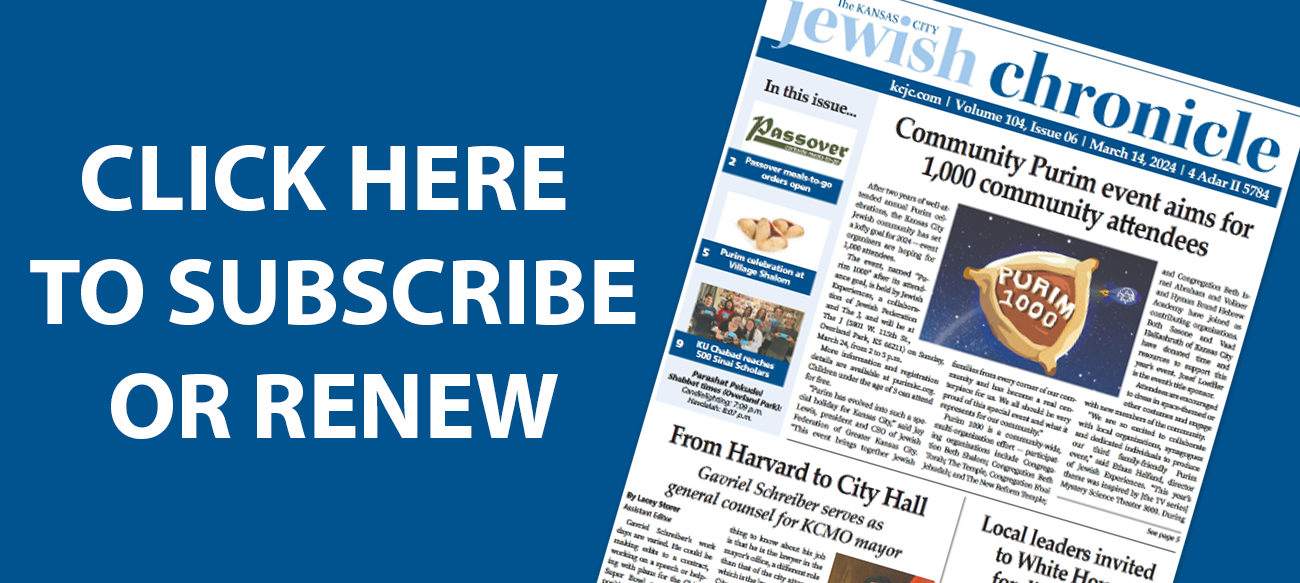
Union Station, MCHE partner to host international exhibition in K.C.
Union Station will host one of the most comprehensive Holocaust exhibitions about Auschwitz ever exhibited in North America, “Auschwitz. Not long ago. Not far away.” The exhibition is being brought to Kansas City in partnership with the Midwest Center for Holocaust Education (MCHE) and will open in June 2021. MCHE will host a series of public and educational programming that will feature experts on the Holocaust and be available through the exhibition.
“This exhibition, and in turn the educational programming around it, explores the entire scope of the Holocaust,” said MCHE Executive Director Jessica Rockhold on Tuesday at Union Station during a press conference announcing the exhibition.
The exhibition, Rockhold said, will bring artifacts to serve as witnesses and corroborate the stories survivors have told for decades. Having these Holocaust artifacts in Kansas City for our community to see is “incredibly significant and an unprecedented opportunity.”
“We look forward to the profound impact it’s going to have here,” she added.
Kansas City is the second, and final, stop on this U.S. tour. Characterized as “a story to shake the conscience of the world,” it has been on display in New York at the Museum of Jewish Heritage — A Living Memorial to the Holocaust since May 2019 and is expected to close May 2. An exact opening date in Kansas City has not yet been announced.
“Auschwitz. Not long ago. Not far away.” features more than 700 original artifacts, 400 photographs and unpublished memoirs, many of which have never been available to the public.
“Over the last five years, our board of directors and professional team have worked tirelessly with Musealia and the Auschwitz-Birkenau State Museum (ABSM) in Poland, the producers of the exhibition, in order to bring this to our community, region and country,” said Union Station President and CEO George Guastello. “Musealia and the ABSM, in turn, worked with dozens of other international museums, institutions and private collections to assemble this significant presentation. We traveled to Europe and saw first-hand the haunting pictures, objects and stories of the victims of the Holocaust. Remembering the largest genocide perpetrated in the 20th century is imperative for the education of our future generations. It is important that we continue to tell the story in an effort to educate and bring to light the hatred that led to the human catastrophe of Auschwitz. We must never forget.”
MCHE’s Rockhold said this is the second time MCHE has partnered with Union Station in bringing an exhibition to Kansas City. The first was in 2000 when the agencies presented “Remember the Children: Daniel’s Story.”
“Twenty years later we are honored to again be partnering with Union Station to bring such an important educational experience to Kansas City and the Midwest. The importance of an exhibition like ‘Auschwitz. Not long ago. Not far away.’ cannot be overstated,” Rockhold said. “Most people will never have the opportunity to travel to Auschwitz and other Holocaust sites. This exhibit offers access to those precious artifacts that personalize and make tangible the history we learn in books.”
Guastello said MCHE is an essential partner in this endeavor.
“They have 26 years of history in this community telling the stories of survivors and the Holocaust.”
Guastello also mentioned Union Station board member Charles Sosland and the Sosland family in his remarks, thanking them for their support in bringing this exhibition to Kansas City.
“This is one of the most expensive exhibitions in Union Station history, and one of the most important.”

Bank of America — the presenting sponsor — continues its tradition of bringing stories and histories of great importance to local, regional and national audiences who visit Union Station.
“In the unfamiliar isolation of a global pandemic, we look for stories of strength and courage and grace,” said Kansas City Market President for Bank of America Matt Linski. “Those themes will be here, in abundance, to inspire and empower us to never forget what hate destroys. We are proud to help our longstanding partner, Union Station, illuminate hope and humanity. Understanding the individual and collective tragedy captured in this exhibition is more important than ever.”
The exhibition story will unfold across Union Station’s 20,000 square feet Bank of America Gallery and introduce objects and Holocaust survivor testimony through 20 thematic galleries.
“The aim of this meticulous and poignant exhibition is to discover the complex reality of the Nazi German concentration and extermination camp Auschwitz-Birkenau within its historical context, as well as to examine how such a place could come to exist and the terrible historical and human consequences derived from the Holocaust,” said Luis Ferreiro, director and CEO of the exhibition. “Auschwitz did not start with gas chambers. Hatred does not happen overnight; it builds up slowly among people. It does so with words and thoughts, with small everyday acts, with prejudices. When we had the vision to create the exhibition, we conceived its narrative as an opportunity to better understand how such a place could come to exist, and as a warning of where hatred can take us to. Therefore, it is of vital importance to remember the road that led to Auschwitz and the consequences it had.”
“Today, the world is moving in uncertain directions,” said Dr. Piotr Cywinski, director of the Auschwitz-Birkenau State Museum. “That is why we need to rely more on the strong foundations of our memory. Auschwitz and the tragedy of the Shoah are part of those foundations, which cannot be bypassed in creating a new face of the world. Nothing can replace a visit to the authentic site of the biggest crime of the 20th century but this exhibition can become a great warning cry for us all and allow people who may never get the chance to visit an opportunity to see and experience it like never before.”
“Auschwitz. Not long ago. Not far away.” explores the dual identity of the camp as a physical location — the largest documented mass murder site in human history — and as a symbol of the borderless manifestation of hatred and human barbarity.
The exhibition will allow visitors to experience artifacts from the Auschwitz-Birkenau State Museum including hundreds of personal items — such as suitcases, eyeglasses and shoes — that belonged to survivors and victims of Auschwitz. Other artifacts include concrete posts that were part of the fence of the Auschwitz camp; fragments of an original barrack for prisoners from the Auschwitz III-Monowitz camp; a desk and other possessions of the first and the longest serving Auschwitz commandant Rudolf Höss; a gas mask used by the SS; Picasso’s lithograph “Head of the Auschwitz prisoner”; and an original German-made Model 2 freight wagon used for the deportation of Jews to the ghettos and extermination camps in occupied Poland.
Exhibition visitors will trace the development of Nazi ideology and the transformation of Auschwitz from an ordinary Polish town known as Oswięcim to the most significant Nazi site of the Holocaust — at which approximately 1 million Jews, and tens of thousands of others, were murdered. Victims included Polish political prisoners, Sinti and Roma, Soviet POWs, Jehovah’s Witnesses, and those the Nazis deemed “homosexual,” “disabled,” “criminal,” “inferior” or adversarial in countless other ways. In addition, the exhibition contains artifacts that depict the world of the perpetrators — SS men who created and operated the largest of the German Nazi concentration and extermination camps.
Union Station officials anticipate guests from local, regional, national and even international origins to attend the exhibition.
“Union Station has earned a stellar international reputation for presenting culturally important and historically significant content,” Union Station Board Chairman Ramon Murguia said. “This exhibition puts a particular point on that. We expect to welcome visitors not only from our local and regional areas, but also nationally and even internationally. This is a once-in-a-lifetime experience and we are deeply honored to be a part of this international exhibition of unprecedented importance. I encourage everyone to make plans to attend and I especially want to thank all our partners and supporters who are making this possible.”
“Auschwitz. Not long ago. Not far away.” was conceived by Musealia and the Auschwitz-Birkenau State Museum and curated by an international panel of experts, including world-renowned scholars Dr. Robert Jan van Pelt, Dr. Michael Berenbaum and Paul Salmons, in an unprecedented collaboration with historians and curators at the Research Center at the Auschwitz-Birkenau State Museum, led by Dr. Piotr Setkiewicz.
“All through the exhibition there are stories — stories about individuals and families, stories about communities and organizations, stories about ideologies that teach people to hate, and responses that reveal compassion and love. There are stories of victims, perpetrators and bystanders, stories with heroes and villains — stories that all merge into an epic story of a continent marked by war and genocide,” said Dr. Robert Jan van Pelt, the exhibition’s chief curator. He has published several books on the camp, including the award-winning “Auschwitz,” “1270 to the Present” (1996) and “The Case for Auschwitz” (2002).
VIP/Anytime exhibition tickets are now on sale for $25 at unionstation.org. A precise June 2021 opening date will be announced in the coming months. Buyers of advance “VIP/Anytime” tickets will be given first option to reserve their exact time of exhibition visit.
Additional information for this story was provided by Lacey Storer.


